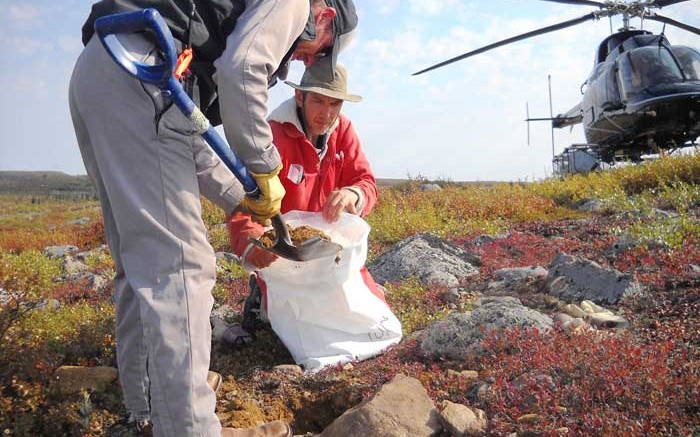Randy Turner — the man who guided Winspear Diamonds from the discovery of the Snap Lake diamond deposit in northern Canada to its sale to De Beers for $305 million in 2000 — is back at diamond exploration in the same part of Canada’s far north, this time with Canterra Minerals (TSXV: CTM; US-OTC: CTMCF).
In April the junior announced it had staked 43 mineral claims covering more than 430 sq. km in prime diamond country: the southern part of Slave province in the Northwest Territories between De Beer’s Snap Lake diamond mine, and the Gahcho Kué project owned by De Beers and Mountain Province Diamonds (TSX: MPV; NYSE-MKT: MDM).
Slave province includes the prolific Lac de Gras and Southern Slave areas that host three of Canada’s four producing diamond mines.
Canterra’s staking adds three properties to its portfolio and expands two others, bringing the company’s total land holdings in the Southern Slave to 726.2 sq. km. All the properties host indicator mineral trains composed of G10 garnets, chromites and ilmenites that could be associated with diamond-bearing kimberlite sources, the company says.
In early October Canterra said that partial analysis of basal till samples from its property portfolio have returned encouraging results.
At its Marlin property, 265 km northeast of Yellowknife, 20 km from the Gahcho Kué project, and contiguous to the north and west of Kennady Diamonds’ (TSXV: KDI; US-OTC: KDIAF) Kennady North project, 126 basal till samples were collected and yielded a 1-by-1-by-1.4-millimetre, off-white, modified octahedral diamond.
Canterra completed a geophysical program using the HeliFALCON gravity gradiometer system and airborne magnetics. The compnay had a 1,500 line km survey flown over the northern part of the Marlin property at a 75-metre line spacing and an average 45 metres above ground, and the company expects to isolate any high-definition gravity and magnetic anomalies. The results also include anomalous indicator minerals, including pyropes recovered from neighbouring samples.
In August, Canterra optioned the property to Margaret Lake Diamonds (TSXV: DIA). Under the agreement Margaret Lake can earn up to 49% in the 260 sq. km Marlin property by making staged cash payments totalling $100,000, issuing 600,000 common shares and spending $1.8 million on exploration over three years.
Paul Brockington, Margaret Lake Diamonds’ president and CEO, said that with the agreement, the junior has ground under option that surrounds Kennady Diamonds’ northern and western property boundaries, and is happy to combine the knowledge base of the two companies’ management teams.
Turner says Canterra inherited “an excellent library of data” from Winspear, with sampling data stretching back to 1995. When Winspear was acquired by De Beers in 2000, it spun out Diamondex Resources, which retained all of Winspear’s data on diamond exploration — excluding the material concerning Snap Lake. (Diamondex changed its name to Canterra in 2009.)
Some of Canterra’s directors have been with the company since Winspear. One is John McDonald, a geologist who was Winspear’s vice-president of exploration and who along with his technical team discovered Snap Lake.
Another seasoned diamond explorer on Canterra’s board is James Eccott, who from 1992 to 2000, as president and CEO of Dia Met Minerals, was involved in the discovery of the Ekati mine, Canada’s first diamond mine.
“We are one of the more active exploration companies in the Southern Slave, outside of Kennady Diamonds,” Turner says in an interview from Vancouver. “We expect to have all of our results back before Christmas from airborne and till samples, and then we’ll design a program that will include more airborne and geophysics with intent to define drill targets.”
“We have a good land position and some good targets, and over the next while we’ll be doing community consultations and having meetings with the Metis First Nations up there in the latter part of November,” he adds.
Turner says that by the time Canterra’s team gets back on the ground in March and April — “you can’t get out there much sooner unless you’re flying” — the company will have “some well-defined targets for further exploration.”
In addition to Marlin, Canterra’s property portfolio includes the Gwen property, 260 km northeast of Yellowknife; the Hilltop property, 45 km southwest of the Snap Lake mine; the King property, 230 km northeast of Yellowknife and 8 km north of Snap Lake; and the Prism property, 200 km northeast of Yellowknife and 35 km south of Snap Lake.
And the company is still adding to its portfolio in the Northwest Territories.
“There will be more staking,” Turner says. “We haven’t finished yet — we like what we see.”
In Alberta, the company owns 33% and is the operator of the Buffalo Hills property, 400 km northwest of Edmonton in the province’s Buffalo Head Hills region, which Canterra says hosts the third-largest district of diamond-bearing kimberlites in Canada, after Lac de Gras in the Northwest Territories and Fort à la Corne in Saskatchewan.
Canterra’s partners at Buffalo Hills are Shore Gold (TSX: SGF) and Encana (TSX: ECA; NYSE: ECA).
As for the diamond sector’s fundamentals, Turner says supply is going down while demand rises by 10% a year from Asian buying. “The U.S. market is still the strongest at 40% of demand for polished goods, but the Chinese market is now 15%, so there has been a swing into China and Southeast Asia,” Turner says. “There is a real renewed interest in the diamond market because there hasn’t been a major diamond discovery in fifteen years.”
Turner adds that the diamond mines in Russia and South Africa are being mined out, while Canada’s Ekati mine has produced since 1996.
“Mines do have a limited life, so it’s the right opportunity — right now — to be in the diamond sector, especially if you have the pedigree to explore and have the knowledge.”


Be the first to comment on "Canterra carves out more ground in diamond country"